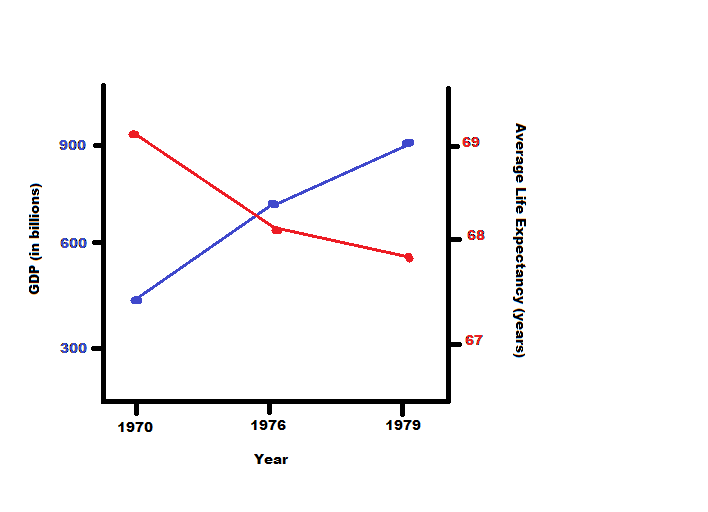A recent Washington Post article reports that GDP has seen a recent uptick. While such news is most likely indicative of economic progress, this is not always the case. National output is not synonymous with the social economy, and as such, should always be evaluated with a critical eye.
Prior to WWII, there was very little collection of aggregate macroeconomic data. The Keynesian revolution shifted policymakers’ goals, however, and they began to more highly value a measurement of output in order to better “manage” the national economy. Thus, GDP was increasingly seen as a way to measure whether the “target” growth rate was being achieved. But the GDP possesses some serious shortcomings as a measure of economic growth, and should not be relied upon as the sole means of determining the health of an economy. As longtime BEA head warns, figures like GDP “are eminently useful in macroeconomic analysis if they are not regarded as a precision instrument and…may be lethal if they are.”
In short, GDP can be defined as the market value of current, final, domestic production during a specific interval of time. This means that all production is summed in terms of their market prices, only the value of final goods is included (as opposed to including the value of all intermediate sales), and only the output of productive factors located in a particular nation is counted. Already, some of the shortcomings of GDP as a measure of social welfare can be inferred, but I will highlight a few of them below.
Perhaps the most significant shortcoming of GDP as a measure of economic growth is its inclusion of government spending alongside other voluntary market transactions. This detracts from GDP’s usefulness as a measure of economic growth because government expenditures are not necessarily beneficial to social welfare, or at least not as beneficial as their cost would indicate. Indeed, there is no way to measure the value of a government service in terms of other goods because the transaction is coerced: it is not undertaken voluntarily by between contracting individuals in order to satisfy their ends and therefore increase their total welfare. Rather, money is coerced from private individuals who may indeed utilize the services provided, but may not have purchased them if they had the opportunity to opt out. The price for government services is not set by the market, and thus the calculation of their value is marked by a significant measure of arbitrariness.
GDP also fails to discount those economic activities that do not directly raise individual welfare. Military spending is the most obvious example of such an activity. While defense services may be seen as necessary to allow other economic activities to flourish, they are not valued for their own sake. Thus, if a nation’s GDP increases by 15% over the course of two years because of increased military spending, that does not mean that such a nation is consuming and investing more. As Roy Webb puts it: “Citizens of a nation that is able to obtain adequate defense for 1% of GDP can consume and invest more, thus having a higher standard of living, than citizens of a nation with the same GDP who had to spend 10% of GDP for defense.”
Another shortcoming is GDP’s failure to account for productive non-market activities. A mother raising a child, for example, is an extremely important activity. But it is not something that is paid for or provided on the market. Thus, such activity is not accounted for in the GDP. This might seem like an insignificant point, but many non-market activities can increase social welfare, and the aggregate of all productive non-market activities is certainly significant–indeed, GDP does not account for any unpaid work whatsoever, no matter how productive.
Yet another shortcoming is that certain destructive events or activities can increase GDP while decreasing overall welfare, making the GDP an inaccurate gauge of social welfare. A massive hailstorm that creates demand for thousands of new roofs and windows in a particular region, for example, is not an economically beneficial event (if you don’t believe me, read about the Broken Window Fallacy on our common economic fallacies page). But it would have the effect of increasing GDP, as millions would be spent on acquiring these goods and services.
Here is another way to think about that last point. Consider divorce, which causes an immense amount of emotional strife for those involved. A high divorce rate is something almost no one considers beneficial. But divorce is expensive, and creates thousands of jobs for lawyers, judges, and other legal mediators. If the divorce rate were to increase by 10% one year, this would increase GDP. Overall welfare (which is determined by subjective preference and is thus immeasurable), however, would almost certainly decrease significantly.
Here is a real-life illustration of the above shortcoming. While the Soviet Union saw massive increases in GDP between 1970 and 1980 (from $430 billion to over $900 billion), the average life expectancy of a Russian male over the same period actually decreased. Alcohol abuse was rampant, infant mortality began to climb, and the crude death rate reversed its previously downward trend. Perhaps the Soviet Union was producing more, but quality of life and overall social welfare definitely took a hit in 1970s Russia. For a visual representation, see my (somewhat crude) chart below:
The above shortcomings are only a few of the many problems with GDP. Needless to say, the figure should never be relied upon as an accurate assessment of economic growth. It certainly has its uses, and by no means would I advocate abandoning the figure altogether. But as with any other index, one must be cautious when using the figure to make judgments about the economic health of any nation. Frank Shostak has an excellent analysis of GDP that I highly recommend to anyone interested in understanding more fully the uses and shortcomings of the GDP figure.



The explanations given in the GDP shortcoming are very narrative and easy to understand with very good living example
The explanation has greatly increased my awareness as it was confusing to understand the shortcomings before reading this article
Analytically there are contradicting issues that narrow down GDP data corrections and hence statistical data selection which I think would rather be considered for better planning and accurate information
Now the trickier part. What would be the economic equivalent of a compass? We need to measure the direction of economic travel in a way that’s comparable to how GDP measures its speed – easy to communicate, and amenable to being influenced by policy decisions.